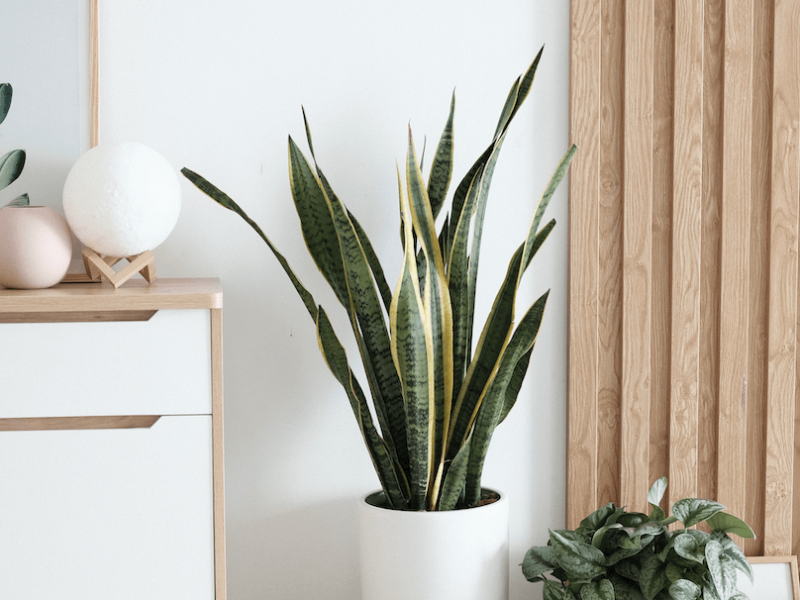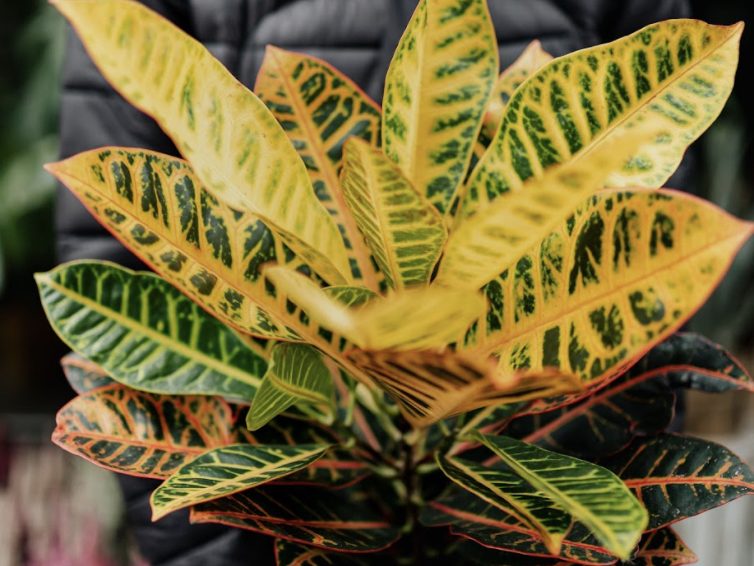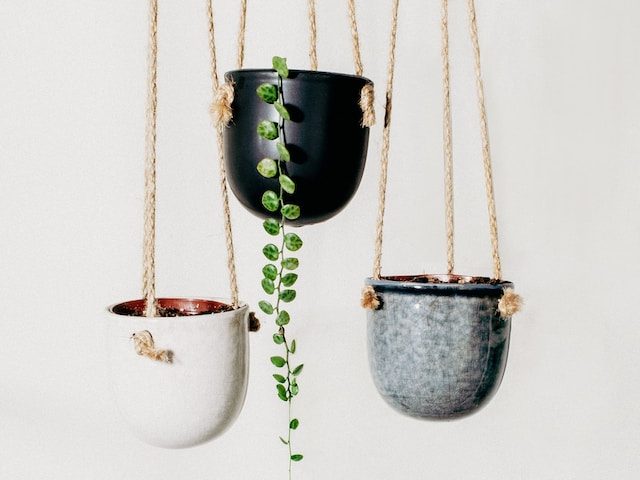
Our favourite houseplants with striped leaves
There’s a lot of incredible foilage out there, but not much beats a stripey leaf! They bring something a little different to a collection of plants and the stripes make each of these plants really stand out in a room. We have curated a list of our favourite striped houseplants which we hope you’ll fall in love with as much as we have! Some have dark moody stripes, others white, silver and even pink!
We have also included a little bio for each of the plants, with important information as well as care tips so you can figure out which is best for you and your home.

Pinstripe Calathea
Calathea ornata
This is probably one of our favourite houseplants here at Fiddle and Thorn. Whilst they are a little fussier than a lot of other plants, their stunning pink striped leaves really make up for it. Their dark green glossy leaves can reach up to around 30cm when your plant starts to mature, so they really stand out in a room of plants.
Native to South America, these plants need high humidity or you’ll very quickly see dry leaf edges appear. You also want to keep them away from intense light or the pink stripes will start to fade which is always devastating. Oh, and if you needed another reason to love the Pinstripe Calathea, they are safe for pets and humans so you don’t need to worry about having them around your home.
Find out more in our Pinstripe Calathea care guide.

Spider Plant
Chlorophytum comosum
Spider Plants are the perfect plant for a houseplant beginner as they are super easy to care for, grow pretty quickly, and produce an abundance of spider babies which can be propagated in seconds.
The best thing about Spider Plants is that you would really have to try to kill them as they adapt to and survive in most environments and don’t mind being a little neglected. They even show you when they need more water by going quite light green. But after a little bit of water, they spring back to full health in minutes.
As your plant matures, you’ll start to see it sprouting little spiderettes which you can choose to remove from the plant to create new Spider Plants. They really are the gift that keeps on giving.
Find out more in our Spider Plant care guide.

Zebra Cactus
Haworthiopsis attenuata
Named after their white striped leaves, Zebra Cacti are super easy to care for and pretty much thrive from being forgotten about. Native to South Africa, this small succulent needs a good amount of sunshine and warmth to thrive but humidity is something you really don’t need to worry about with these plants. As with a lot of other succulents, water your Zebra Cactus sparingly as they are quite sensitive to overwatering and leaf rot.
With the right care and environment, you should expect to see your Zebra Cactus bloom but don’t get too excited as the flowers can be quite underwhelming. But to make up for it, these plants are non-toxic so safe for children and pets that might be tempted to nibble on the leaves.
Find out more in our Zebra Cactus care guide.

Inch Plant
Tradescantia zebrina
Also known as the Inch Plant, we haven’t yet come across a faster-growing or easier to propagate houseplant. Native to the tropics of Mexico and South America, these plants offer something different with their purple and silvery leaves that transcend out of the pot.
Growing these indoors helps keep their growth more contained whilst still giving that wilderness feel which we love. Caring for these plants is also super easy as all they need is ample light and moderate water. They are quite forgiving though so won’t give up straight away if something’s a little off.
These plants are great for hanging planters or when placed on shelving so you can really make the most of those incredible vines. They can be mildly toxic though so you’ll want to keep them away from pets.
Find out more in our Inch Plant care guide.

Snake Plant
Sansevieria Trifasciata
The bold and striking leaves of the Snake Plant make it stand out wherever you put it! Not only are they slow-growing, but they transcend upwards so are great for small spaces or that corner you never know what to do with. They have some of the sturdiest leaves or any houseplant, and their sharp leaf tips have given the plant the nickname of mother-in-laws-tongue!
When it comes to care, Snake Plant are super easy to look after, they can adapt to a range of light levels (are great low light plants), prefer dry soil and don’t need much attention in the way of misting or repotting etc. So if you want a low maintenance, sturdy houseplant, then the Snake Plant is your perfect match!
Find out more in our Snake Plant care guide.

African Mask Plant
Alocasia amazonica
If there is one plant that has risen up the popularity ranks recently, it’s the African Mask Plant! You can now buy these at basically every plant shop, market and superstore globally as they are definitely the most popular of the Alocasia family. And we totally understand why they have become so popular, their intense glossy shield-like leaves are adorned with strong white veins which really make them something special.
They aren’t a great plant for beginners, however, as they do require decent light levels, as well as warm temperatures and a consistent high humidity level. Misting this plant is really crucial or it’ll start to develop some issues.
If in the right environment, your African Mask Plant can grow well above 1 metre but this will take many years as they don’t produce that many new leaves each year. This is why it’s crucial you take good care of the leaves your plant does have by regularly dusting and inspecting for issues.
Find out more in our African Mask Plant care guide.

Zebra Plant
Aphelandra squarrosa
We’re seeing this plant pop up more and more which makes us super happy! Known and adored for their dark green leaves with striking white veins, the Zebra Plant is pretty slow growing but can reach up to a couple of feet when grown indoors.
Native to Brazil, these plants need high humidity, warm temperatures and bright but indirect light. When it comes to watering, they like their potting mix to be consistently moist but not soggy which can be a bit of a challenge for more novice plant parents.
Zebra Plants are also non-toxic so you don’t need to worry about having them around your family or furry friends.
Find out more in our Zebra Plant care guide.

Calathea Orbifolia
Calathea Orbifolia
With their striking green and silver striped leaves, the Calathea Obifolia is the perfect plant for those looking for a little something different as they transport you straight to the tropics! There are a few things to look out for when caring for a Calathea Obifolia, firstly, avoid direct sunshine as this will burn their beautiful leaves. They also like some moisture in the soil but hate sitting in soggy soil, so finding the right balance is key.
Another thing we love about Calathea Obifolia plants is that they are safe for pets and humans, so you don’t need to worry about bringing them into your home. Although it was once slightly rare, you should now be able to get your hands on one of these pretty easily in nurseries and larger plant shops around the world.
Find out more in our Calathea Orbifolia care guide.

Moses in the Cradle
Tradescantia spathacea
This slightly rarer houseplant is an incredible find and is also a really low maintenance houseplant. It’s the perfect addition for those looking for something a little different but may not be looking for a challenging plant. It gets its name from the small white flowers that grow in small boat-shaped bracts nestled in the leaves.
There are a few things to note before deciding that the Moses-in-the-Cradle is the plant for you. Firstly, they love a higher humidity level so it’s important that you mist your plant a few times a week, or buy a humidifier that will keep a consistent level. Moses-in-the-Cradle plants are also toxic to humans and pets so keep them away from those who might be tempted to nibble on their incredible pink leaves.
Find out more in our Moses in the Cradle care guide.

Peacock Plant
Calathea makoyana
The Calathea makoyana is known and loved for the bold and unique markings on the leaves, as well as their red undersides, a classic trademark of many Calathea plants. Peacock plants don’t grow very tall so are perfect for smaller homes and spaces.
When it comes to care, it’s important to note that the Peacock Plant can be a little temperamental sometimes, so we don’t always recommend this one to plant beginners. You must keep them away from direct light, mist them to boost the humidity and never let them fully dry out for long periods of time. They also need quite warm temperatures to really thrive, so drafts and AC vents are a no-go for Peacock Plants.
Peacock Plants can grow very small white flowers sometimes, but don’t think you aren’t caring for your plant properly if it doesn’t bloom. Flowers are quite rare and unpredictable, but a nice surprise when it does happen!
Find out more in our Peacock Plant care guide.

Philodendron Birkin
Philodendron Birkin
This used to be an extremely rare and unknown plant but over the past few years, it’s definitely gained a place in the houseplant walk of fame! Unlike a lot of its Philodendron relatives, the Birkin is a non-vining plant that stays pretty compact, making it great for windowsills and smaller spaces.
Loved for their green and cream striped leaves, the Philodendron Birkin needs a humid environment to really thrive. This is because they are native to the rainforests of Brazil so be prepared for regularly misting (or just buy a humidifier), as otherwise, you’ll see brown leaves appear pretty quickly. With the right care and environment, the Birkin can be a pretty quick grower so it’s definitely worth a little bit of extra hassle.
Find out more in our Philodendron Birkin care guide.

Croton Plant
Codiaeum variegatum
If you’re looking to bring a splash of colour into your home, then the Croton Plant is the perfect choice. Native to India and Indonesia, the unusual thing about Croton Plants is that they are genetically unstable which means every single plant will look slightly unique. Even when propagated, the new plants can look different to the mother plant.
There are so many types of Croton Plants showcasing red, yellow, pink, purple, orange and white leaves but luckily they all have the same care requirements. Like most other tropical plants, they need ample light, a moderate amount of water and a nice warm room to really thrive. It’s best to keep this one away from pets though as although it’s not the most toxic plant, it can cause some irritation when ingested.
Find out more in our Croton Plant care guide.

Prayer Plant
Maranta leuconeura
Native to the tropical rainforests of Brazil, the Prayer Plant is loved for its variegated leaves with intricate vein patterns. You can easily spot a Prayer Plant by its leaf undersides as shades of deep red are revealed when the plant’s leaves curl up at night, bringing a splash of colour to your home.
There are several varieties of Prayer Plants that all look ever so slightly different. The most common is the tri-colour which has red-veined leaves but you’ll sometimes see varieties with silver patches or dark green splashes. Prayer Plants are a little fussy though with light conditions, soil moisture and humidity levels though so we don’t recommend this as a starter plant, unfortunately.
Find out more in our Prayer Plant care guide.

Watermelon Peperomia
Peperomia argyreia
There aren’t really many leaves that are more beautiful and striking than those of the Watermelon Peperomia. It’s not difficult to know where they got their name from, as their silvery stripes steal the hearts of plant parents everywhere.
They are quite a delicate plant though, as their large heavy leaves are held up by relatively weak stems so be prepared to lose a few leaves here and there. Another thing to be prepared for when owning this plant is all of your friends wanting a cutting, but luckily this plant is super easy to propagate so no problems there!
Native to South Africa, the Watermelon Peperomia prefers mid-light levels, as they are used to the dappled conditions of the jungle floor. Oh, and as they are a semi-succulent, it’s important you don’t water this one too much or the stems can give up and the whole plant will droop and wilt.
Find out more in our Watermelon Peperomia care guide.














